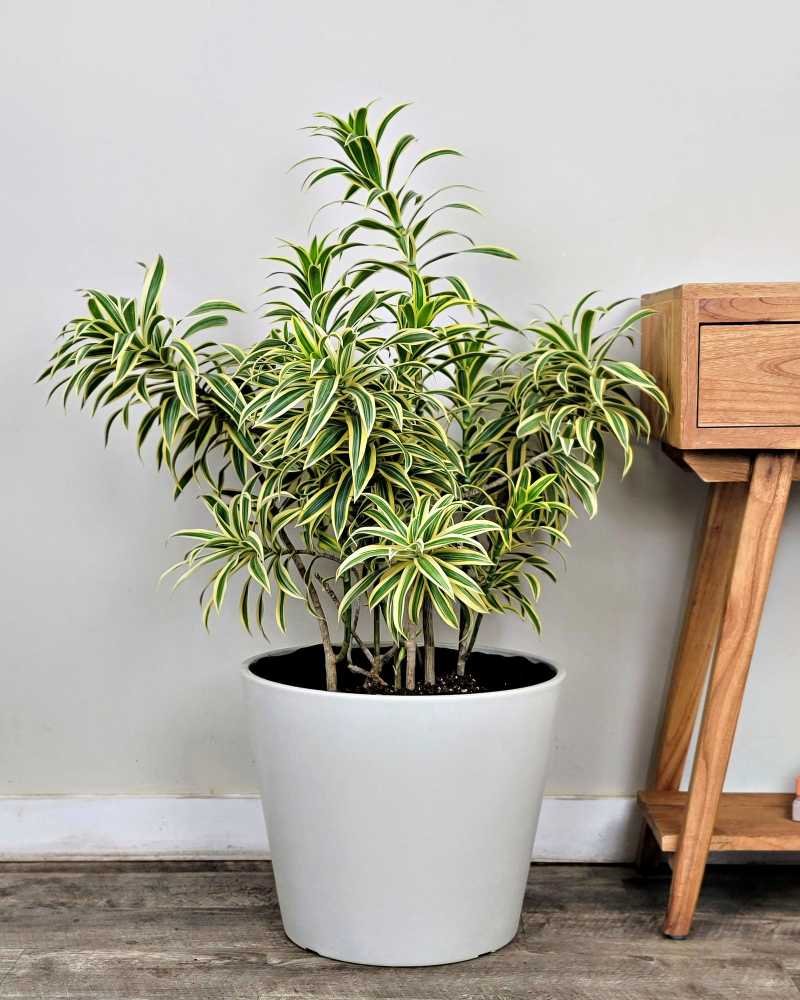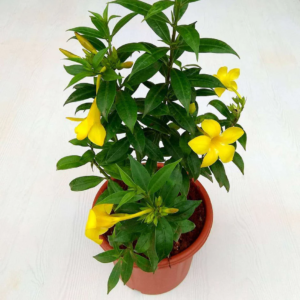Description
Song of India Plant (Dracaena reflexa): A Complete Overview
The Song of India, scientifically known as Dracaena reflexa, is a striking ornamental houseplant known for its vibrant foliage, structural elegance, and air-purifying qualities. Native to the islands of the Indian Ocean, including Madagascar, Mauritius, and Mozambique, this plant is admired around the world for its low-maintenance nature and lush, tropical appearance.
Botanical Classification
- Scientific name: Dracaena reflexa
- Common names: Song of India, Pleomele, Reflexed Dracaena
- Family: Asparagaceae
- Genus: Dracaena
This species belongs to the same family as other popular indoor plants like Dracaena marginata and Dracaena fragrans, sharing many of the same desirable qualities—especially its adaptability to indoor environments.
Physical Description
The Song of India is most admired for its foliage—long, narrow leaves that are pointed at the tips and typically variegated with shades of green edged with bright yellow or cream. These leaves grow in a spiral arrangement around the stem, creating a visually appealing and symmetrical form. The plant typically reaches a height of 3 to 6 feet indoors, though it can grow much taller in its natural habitat.
The stems of the plant are woody and can be trained or pruned to develop a more tree-like form, or allowed to grow freely for a fuller, bushier appearance. The plant grows relatively slowly, which makes it especially ideal for indoor cultivation.
Native Habitat and Growth Conditions
In the wild, Dracaena reflexa grows in tropical climates with plenty of rainfall, moderate humidity, and filtered sunlight. It is native to countries with warm, humid environments, such as Madagascar and other Indian Ocean islands, and thrives under tropical forest canopies.
In cultivated settings, especially indoors, the plant mimics its natural environment best when placed in a well-lit area with indirect sunlight, and when kept away from cold drafts or extreme temperature changes.
Caring for the Song of India
One of the reasons for the plant’s popularity is its low maintenance requirements, making it suitable for both novice and experienced plant enthusiasts.
Light Requirements
Song of India prefers bright, indirect light, although it can tolerate moderate light levels. Variegated forms require brighter light to maintain their vivid coloration. Direct sunlight may scorch the leaves, so filtered light is ideal.
Watering
This plant likes to be kept moderately moist but is sensitive to overwatering. The soil should be allowed to dry out slightly between waterings. During the growing season (spring and summer), water when the top inch of soil is dry. In fall and winter, reduce watering frequency.
Soil and Drainage
A well-draining potting mix is essential. A standard indoor potting soil combined with perlite or coarse sand provides good drainage. Root rot can occur if the plant sits in waterlogged soil for extended periods.
Humidity and Temperature
Song of India thrives in moderate to high humidity and prefers temperatures between 65°F and 80°F (18°C – 27°C). It is not frost-tolerant and should be kept away from cold windows or air vents during winter.
Fertilization
Feed the plant with a balanced liquid fertilizer once a month during the growing season. Fertilization is not necessary in the winter months when the plant is dormant.
Pruning and Maintenance
Pruning helps to maintain a desired shape and remove dead or damaged leaves. The plant can be pruned at the stem to encourage branching and a fuller appearance. It is also relatively pest-resistant, though it may occasionally suffer from spider mites, mealybugs, or scale insects.
Propagation
Song of India can be propagated easily through stem cuttings. Cut a healthy stem just below a node and place it in water or moist potting soil until roots develop. It is important to ensure high humidity and warmth for the cutting to root successfully.
Indoor and Landscape Use
Dracaena reflexa is ideal as an indoor ornamental plant, often used in living rooms, offices, and commercial spaces for its aesthetic appeal and air-purifying properties. In tropical and subtropical climates, it is also used in landscaping as a hedge, border plant, or container specimen.
It pairs well with modern interiors, adding a touch of nature without demanding excessive care. Because it grows upright and has a distinctive structure, it also serves as a natural room divider or architectural accent.
Air Purification Qualities
According to studies by NASA and other environmental agencies, many Dracaena species are effective at removing toxins from the air, such as formaldehyde, benzene, and xylene. Song of India contributes to a healthier indoor environment, especially when grouped with other air-purifying plants.
Cultural and Symbolic Significance
In various cultures, particularly in Asia and the Pacific, the Song of India plant is considered a symbol of prosperity, protection, and good fortune. It is often given as a housewarming gift or used in spiritual rituals. Its spiral leaf growth and upright posture are thought to bring positive energy and growth.
In Feng Shui, it is believed to promote balance and well-being when placed in specific corners of the home or office.
Common Challenges
Despite its hardy nature, Song of India can face a few issues:
- Leaf browning can result from low humidity or fluoride in tap water.
- Yellowing leaves might indicate overwatering or poor drainage.
- Pests such as mealybugs can be managed by wiping the leaves with insecticidal soap or neem oil.
Keeping the plant in stable conditions with good air circulation usually prevents most problems.
Varieties and Related Species
There are several cultivars and related Dracaena species that resemble or are often confused with the Song of India, such as:
- Dracaena reflexa ‘Variegata’ – the most popular variety with yellow-edged leaves.
- Dracaena marginata – with thinner, spiky leaves and red edges.
- Dracaena fragrans (Corn Plant) – known for its wider, arching leaves.
Each has its own appeal and care requirements but shares the core characteristics of resilience and beauty.
Conclusion
The Song of India plant is a shining example of nature’s artistry—vibrant, sculptural, and easy to care for. Whether grown as a tabletop plant, floor specimen, or garden accent in warm climates, it provides beauty and health benefits with minimal effort. Its elegance and resilience make it a favorite among houseplant enthusiasts and interior designers alike. With the right care, the Song of India can thrive for many years, bringing a touch of the tropics into your living or working space.







 Allamanda- Plant
Allamanda- Plant 

Reviews
There are no reviews yet.